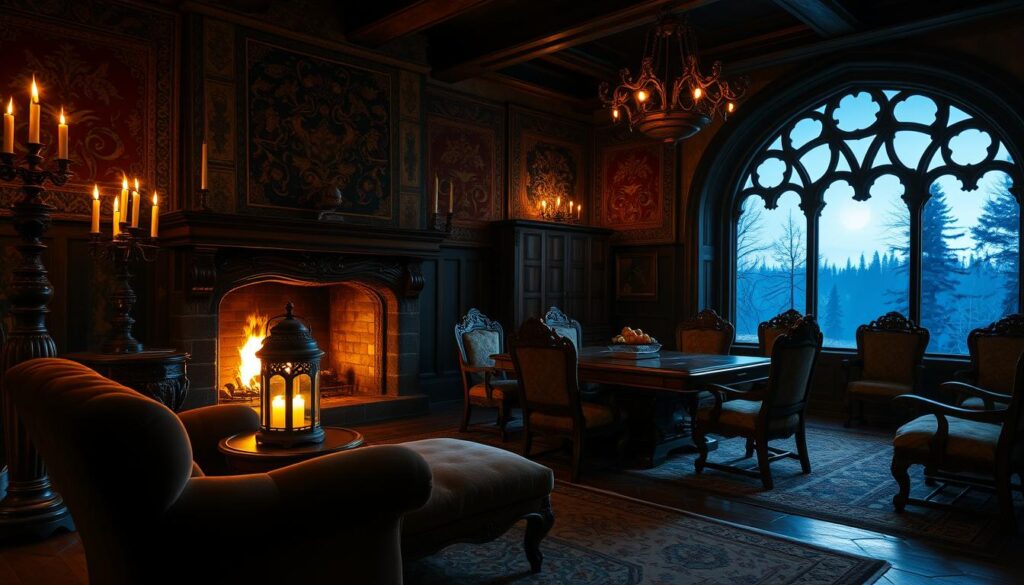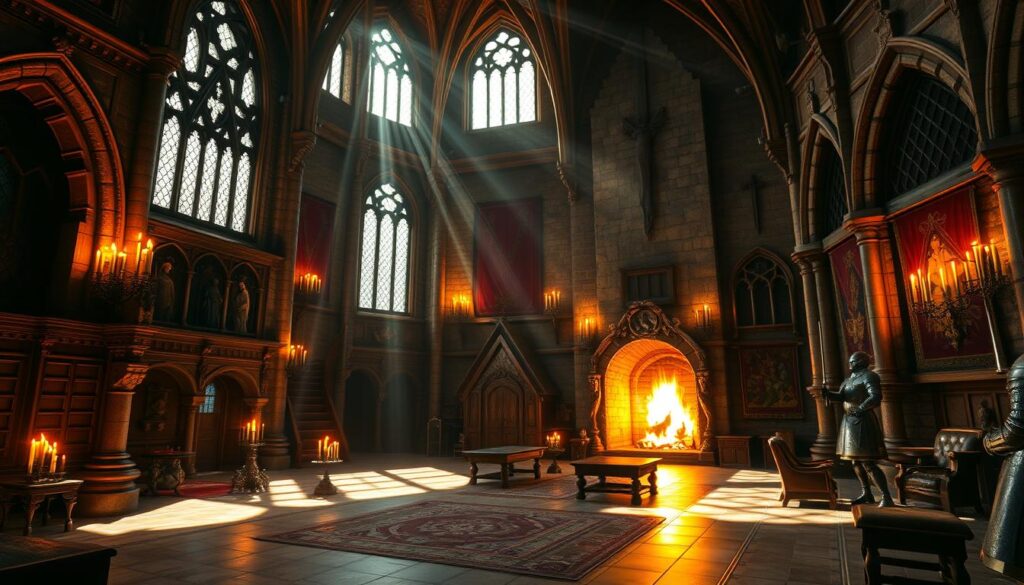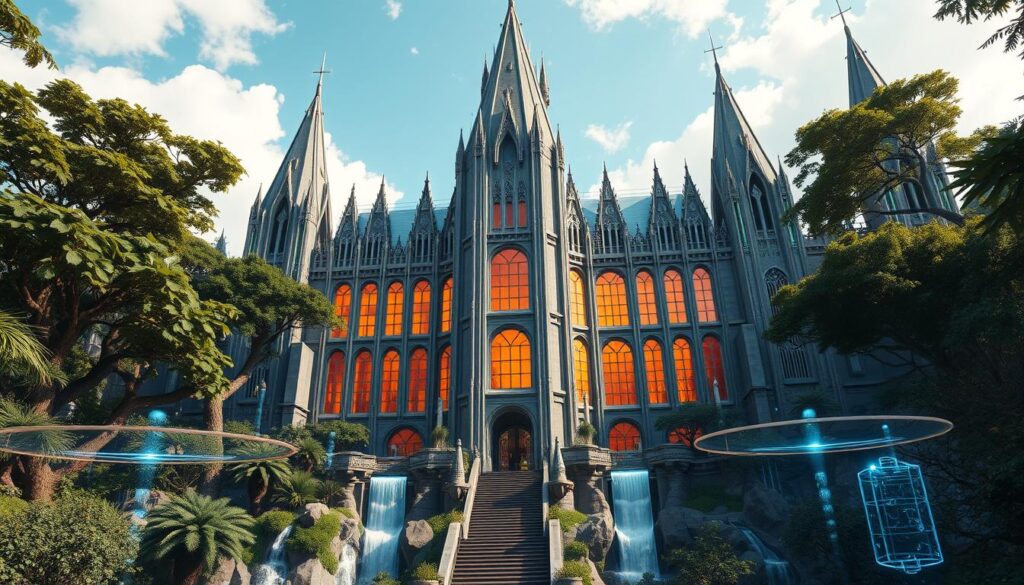For years, sleek and simple spaces dominated home design. But today, a new wave of style is taking over. Inspired by fantasy worlds and medieval charm, castlecore blends history with modern comfort.
Pinterest predicts this aesthetic will be a top choice in 2025. From Tudor-style furniture to velvet drapes, it offers a cozy escape from fast-paced life. Unlike stark minimalism, it embraces warmth and storytelling.
Shows like Game of Thrones and books like Lord of the Rings fuel this shift. People want spaces that feel magical yet functional. Think stone accents paired with Wi-Fi—old-world charm meets today’s needs.
Key Takeaways
- Millennials are moving away from minimalism to richer, storybook-inspired interiors.
- Pinterest highlights castlecore as a rising trend for 2025.
- Fantasy pop culture heavily influences this design shift.
- Mixing historical elements with modern tech creates balanced spaces.
- This style offers a comforting retreat from digital overload.
What Is the Castlecore Trend?
Gone are the days of stark, empty rooms—warmth and character are in. Denver designer Jennifer Rogers defines this movement as a mix of rich textures, earthy tones, and antique details. It’s about creating spaces that feel like a page from a storybook.

Think stone fireplaces, carved wood furniture, and wrought iron light fixtures. Velvet drapes and tapestries add softness, balancing the ruggedness of raw materials. The result? A cozy yet majestic vibe that’s far from cold minimalism.
This aesthetic isn’t entirely new. It echoes the 18th-century Gothic Revival and Arts & Crafts movements. Designer Christiane Lemieux’s castle renovation showcases how modern tech blends seamlessly with medieval charm—Wi-Fi hidden behind stone walls, for example.
Unlike Nate Berkus’ sleek tapestry styling, this design embraces imperfections. It’s a rejection of sterile spaces in favor of ones that whisper history. For more eclectic ideas, explore our guide to boho decor, which shares a love for layered textures.
Ultimately, it’s about crafting rooms that inspire and comfort. Whether through a single iron chandelier or a full stone accent wall, the castlecore aesthetic invites you to live inside your favorite fairy tale.
Why Millennials Are Embracing Castlecore
Digital fatigue is pushing young homeowners toward interiors that feel like historical retreats. With 74% more searches for “medieval decor” on Pinterest in 2024, it’s clear this aesthetic resonates. Social media amplifies the shift—TikTok’s #CastleCore hashtag alone boasts 2.1M views.

The Allure of Nostalgia and Slow Living
From Harry Potter to Game of Thrones, fantasy worlds fuel this craving for cozy, storied walls. Trend forecaster Rebecca Goesling links it to the “slow living” movement—a backlash against today’s fast-paced life. Nearly 68% of millennials prefer “historical” spaces for stress relief.
“Tech fatigue makes people crave tactile, immersive environments.”
Pinterest Predicts a Medieval Maximalism Boom
The platform crowns 2025 as the year of “medieval maximalism.” Velvet drapes, stone accents, and iron chandeliers dominate mood boards. Even fashion echoes this—singer Chappell Roan’s Joan of Arc-inspired 2024 VMAs look went viral.
| Minimalism | Castlecore |
|---|---|
| Sleek, neutral tones | Rich, earthy colors |
| Open, empty spaces | Layered textures |
| Tech-forward | Tech-hidden (e.g., Wi-Fi in stone walls) |
This isn’t just a *trend*—it’s a redefinition of personal space. Millennials want homes that tell stories, not just showcase gadgets.
The Historical Roots of Castlecore
Medieval castles weren’t just fortresses—they were blueprints for today’s cozy, storybook interiors. Their design prioritized warmth and durability, from thick stone walls to hand-carved wood details. Now, these elements are reborn in modern homes.
Key Design Elements from Medieval Castles
Castle walls were built for defense, with few windows creating moody lighting. Today, faux-stone peel-and-stick tiles mimic their rugged texture. Brands like Farrow & Ball offer hues like “Hague Blue,” inspired by natural dyes used in wealthy households.

Tapestries served dual purposes: insulation and storytelling. Modern versions add drama to walls while nodding to history. Case pieces like armoires, once closet substitutes, now appear as statement furniture—like Williams Sonoma’s $1,695 Soho Roll Arm Bench.
“Historical palettes connect us to craftsmanship. Hague Blue isn’t just a color—it’s a legacy.”
Raw materials like iron and wood align with sustainability trends. Wrought iron chandeliers or reclaimed oak tables bridge past and present. The result? Interiors that feel timeless, not trend-driven.
How to Incorporate Castlecore into Your Home
Bring the charm of old-world elegance into your home with these simple upgrades. Whether you’re revamping a single room or your entire space, focus on three key elements: textiles, lighting, and raw materials. These layers create a cozy, storybook atmosphere.

Luxurious Textiles: Velvet, Tapestries, and More
Jewel-toned velvet drapes in emerald or ruby add regal warmth. Designer Jennifer Rogers recommends layering textiles like tapestries over beds or sofas for depth. Pottery Barn’s Greenwood Tapestry ($349) is a standout piece.
For a DIY touch, dye curtains with walnut husks for authentic medieval hues. Pair with Article’s Mysen Cabinet ($599) to balance modern functionality with historical flair.
Lighting: Candles, Chandeliers, and Sconces
Iron chandeliers and sconces elevate the lighting game. CB2’s Vela Sconce (26% off) blends modern safety with medieval aesthetics. For candle lovers, Fredericks & Mae’s iron holders ($50) add rustic charm.
Opt for battery-operated taper candles to combine ambiance with safety. Arhaus’ Artemis Candle Holder ($95) is a sleek option.
Raw Materials: Stone, Wood, and Iron
Peel-and-stick stone tiles from Wayfair mimic castle walls affordably. For investment pieces, 1stDibs’ Swedish armoire ($5,850) offers hand-carved wood details.
Brands like Arhaus (30% off Granby Chair) and Frontgate (15% off Etienne Sideboard) merge durability with design. Reclaimed wood tables or iron accents complete the look.
“Raw materials like iron and wood tell a story. They’re not just decor—they’re heirlooms.”
The Future of Castlecore in Design
2025 will redefine what ‘modern’ means in home decor. Rebecca Goesling predicts *color-drenching*—think oxblood walls paired with crimson dishware—as the breakout technique. This bold approach turns rooms into immersive, storybook settings.

Patinaed metals are replacing sleek finishes, says designer Christiane Lemieux. Brass with a weathered look or hammered iron adds authenticity. 1stDibs reports a 40% yearly rise in medieval-inspired furniture sales, proving demand for *pieces* with history.
Tech Meets Tradition
Smart LED “candles” in iron sconces blend old-world charm with convenience. Reclaimed wood tables paired with hemp tapestries highlight sustainability. Even kitchens get a twist, with herb-drying racks hanging from stone walls—*Cottagecore meets Castlecore*.
| 2020s Minimalism | 2025 Castlecore |
|---|---|
| Monochromatic palettes | Color-drenched walls |
| Polished metals | Patinaed brass and iron |
| Disposable fast furniture | Heirloom-quality investment pieces |
Anthropologie’s 2025 collection leans into gothic arches and hammered brass. As Lemieux notes, “This *aesthetic* is the antidote to disposable fast furniture.” It’s not just a style—it’s a shift toward *interiors* that age gracefully.
Conclusion
Homes are becoming personal retreats that blend history with modern comfort. The castlecore aesthetic proves that design can be both nostalgic and functional. With 62% of millennials favoring Instagram-worthy medieval accents, this style is here to stay.
Start small—try CB2’s $37 iron sconces or a DIY tapestry display. Even Studio McGee’s minimalist take shows the trend’s flexibility. Whether you lean into grandmillennial flair or subtle historical nods, the key is balance.
For more inspiration, explore our guide on 2025 design trends. Ready to transform your space? Share your makeover @HouseBeautiful and join the movement.

